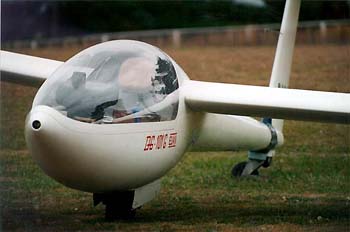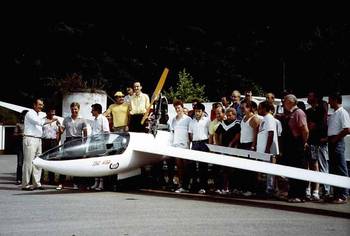25 years DG glider and motor glider
20 years of cooperation DG-Elan
– a Report from 1998 –
25 years ago in August 1973 the construction of the moulds for the standard class glider DG-100 started in Bruchsal Untergrombach.
To accomplish this project Gerhard Glaser, owner of a civil engineering business, and Diplom Ingenieur Wilhelm Dirks, who just had finished his studies at the Technische Hochschule Darmstadt, founded the Glaser-Dirks Flugzeugbau GmbH company.
 The main purpose was to provide sailplanes to the gliding community which are safe to fly. Important safety features, such as docile flight characteristics, the safety cockpit, the high landing gear with large tire and the typical DG canopy with outstanding in-flight visibility were incorporated in the initial design, the popular DG-100. These features are still showing the way.
The main purpose was to provide sailplanes to the gliding community which are safe to fly. Important safety features, such as docile flight characteristics, the safety cockpit, the high landing gear with large tire and the typical DG canopy with outstanding in-flight visibility were incorporated in the initial design, the popular DG-100. These features are still showing the way.
In his college days, Wilhelm Dirks was the principal designer and builder of the famous Akaflieg Darmstadt D-38. Many ideas were taken from the D-38 and transferred to the DG-100. Only 9 month after the start Wilhelm could take off with the DG-100 in May 1974 for the successful maiden flight. Glaser-Dirks produced 105 DG-100 and another 222 units have been produced later at the Elan factory.
In 1977 the 15 m class sailplane DG-200 entered the market. In 1978 the DG-200 was up-dated with 17 m wing tip extensions. The DG-200/17 is one of the most sought after glider on the second hand market.
As early as in 1980 GLASER-DIRKS as one of the first manufacturers took off with the DG-200/17C for the carbon fiber era. Altogether 192 DG-200 have been constructed.
The low weight and the high strength of the DG-200/17C wings made the development of a handy self launching sailplane with retractable power plant possible.
The DG-400 concept was born.
 During 1981 the DG-400 started its triumphal march to a world-wide distribution. with 290 units the DG-400 is still the best sold motor glider of its kind. Numerous motor gliders, but also sailplane records have been set with the DG-400 and some are still unbeaten.
During 1981 the DG-400 started its triumphal march to a world-wide distribution. with 290 units the DG-400 is still the best sold motor glider of its kind. Numerous motor gliders, but also sailplane records have been set with the DG-400 and some are still unbeaten.
The reasons for the wide distribution of the DG-400 are not only the features mentioned above, but especially the simple handling of the power plant, which enabled pilots without special technical knowledge to safely operate such an aircraft.
The engine data display and control unit DEI which was invented by DG showed the way and is still used in all DG-motor gliders in new versions according to the latest state of the art.
In 1978 the co-operation with the Slovenian company Elan began and is still successful. From 1979 on the DG-100 was produced as DG-100 Elan.
In 1983 the new generation standard class glider DG-300 Elan expanded the DG-fleet. The 4 pre-production glider soon could prove their performance during the world championships at Hobbs with several wins of the day. Despite its high performance the exceptional good handling qualities made the DG-300 a favorite of the gliding clubs. Especially the Version DG-300 Club Elan which was designed to replace the DG-100 in the production line and the fully aerobatic Version dg-300 Elan Acro contributed to it’s popularity. The DG-300 is still in production, up until today 484 DG-300 have been delivered.
In 1987 two new DG projects could be presented to the gliding community:
In March the first Version of the two seater family DG-500 could perform it’s maiden flight, the motorized DG-500M followed only 4 weeks later the 15m class sailplane DG-600. The DG-600 was designed from the beginning with 17m wing tip extensions and the potential of the carbon fiber construction was fully used to realize the wing with only 12 % relative thickness.
In 1989 a motorized self launching Version the DG-600M followed.
The DG-600 needs better acquaintance of the pilot to his plane than other glider, but as soon as the pilot is used to it’s peculiarities he will be enthusiastic about the extraordinary quick control response and the outstanding high speed performance.
Due to a fire in the wing production room in the year 1992 the DG-600 production had to be shut down with 112 units produced, as the wing moulds had been severely damaged.
In the meantime different Versions of the DG-500 have been developed.
In 1989 the fully aerobatic Version DG-500 Elan Trainer, with 18m span designed specially for club use and the sailplane version of the DG-500M the DG-500/22 Elan performed their maiden flights. The DG-500/20 Elan with 20m span and winglets designed specially for 20m class two seater competitions followed in August 1993.
During December 1994 the D-500 family was amended by the variable version DG-505 Elan ORION. With 17,2 or 18m span for training and aerobatics and with 20m span for cross country flights this glider is very useful for club operation.
Up till 1998 200 DG-500 of all versions have been completed.
The latest product family is the DG-800 which was optimized for 18m span with wing flaps and equipped with modern wing sections designed by L.M. Boermans from the TU Delft. These sections have very docile stall characteristics and produce extremely simple thermalling characteristics combined with excellent performance. As options all DG-800 versions can be ordered with wing parting and with winglets for 15 m span and also for 18m span.
GLASER–DIRKS was the first glider manufacturer who used the latest technologies for constructing the production moulds. The master models for the wing moulds have been numerically milled in full length and the moulds have been produced from carbon fiber reinforced plastic with integrated heating system. This method provides high precision not achievable with the previous methods and a constant quality for the whole production run.
In May 1993 the self launching version DG-800A and the pure sailplane DG-800S made their maiden flights.
July 1994 the third version DG-800B followed. The self launching DG-800B is DG’s commitment to low noise environmental friendly motor gliding. With a water-cooled buried engine, 3:1 propeller speed reduction and a large silencer inside the fuselage all possibilities to reduce the noise emission were incorporated in the design. The first 5 units are equipped with a British Mid West 2-stroke engine with 50 HPS. Unfortunately the production of this engine was shut down, so no more engines were available. A replacement was found with the SOLO 2625 engine. But this engine was still under development at that time. So a series production of the DG-800B was no longer possible.
The non availability of an engine was one of the reasons which lead to financial problems of Glaser-Dirks company and their bankruptcy in the spring of 1996.
Fortunately the production had to be stopped for only a few weeks. The investors Karl Friedrich Weber and his wife Eva-Marie bought the factory and continued the production of the DG products with great financial and personal effort.
As early as July 1996 the first flight with the 53 HPS SOLO engine was carried out. However it was still a long way to achieve a smooth production run as the SOLO engine had a lot of initial problems. But it was worth all the trouble as the DG-800B is the most powerful, type certified self launcher in the 18m class with the lowest noise emission.
For the two seater motor gliding a new version of the DG-500, the DG-505MB was developed. It is equipped with the engine technology of the DG-800B but with a more powerful version of the SOLO engine with 65 HPS. This glider is the one of it’s kind, producing the lowest noise emission.
If you have read this article carefully you will miss a DG-700. It was planned to be a new standard class sailplane, but the results of the wind tunnel measurements of the wing section, which was designed especially for this glider, were not promising enough to continue this project.
Up to end of August 1998, the 25th anniversary of DG aircraft, the following numbers have been produced:
839 in Untergrombach, 891 at Elan, altogether 1730 DG’s, of which 511 are self launchers.
Scheduled for the end of this year 1998 are a total of 860 glider at DG and 900 gliders at Elan, altogether 1760 DG’s.
– Wilhelm Dirks –
August 1998
